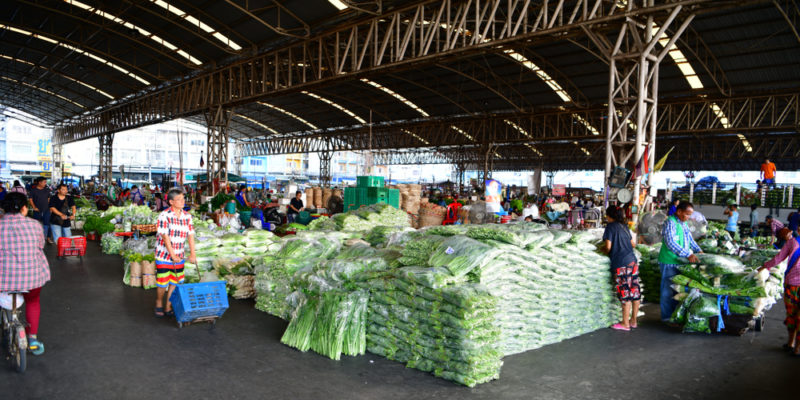We explain what market and market price is. In addition, we explore the types of markets, competition, and more.

What is a market?
In economics, a market is a physical or virtual space where goods, services and liquid assets are exchanged for money. The exchange takes place between buyers and sellers who may interact directly or through entities or platforms. It is a process in which both the seller and the buyer obtain some benefit.
The prices or values of goods and services are influenced by:
- The law of supply and demand (supply refers to the availability of goods and services and demand refers to the number of consumers who want to buy goods and services).
- State regulations.
- The economic situation of the global market.
- See also: Market economy
Market price

Price is the monetary value, i.e. the amount of money necessary for the purchase of a certain good or service in the market which consumers are willing to pay.
The value of a product or service in the market is influenced by several factors including:
- The cost of the manufacturing process. This includes the costs of raw materials, production process, infrastructure, workforce, and logistics costs. If the costs of raw materials increase (due to scarcity, devaluation, or problems related to imports), the price of the final product also increases.
- The productive capacity of a country. It concerns the availability of resources and assets, which when insufficient require the import of supplies or finished products. Low domestic production results in lower profits and incomes and the gradual impoverishment of the population.
- The number of competitors. This includes the existence (or absence) of other suppliers or sellers. If the population has no purchasing alternatives, sellers can set the prices they want, thus generating unfair market conditions.
- The law of supply and demand. It comprises the number of goods or services offered in a specific area or sector, and the demand for these goods or services in the market at any given time.
- If supply of a good or service is high and demand is low, the price will tend to decrease.
- If supply of a good or service is low and demand is high, the price will tend to increase.
- Profit margin or surplus value. It is the amount that the producer or seller wants to obtain as profit. Product selling price must cover production and marketing costs. In addition, the price must imply a profit, in order to make it worthwhile to produce and market the product.
- Value added. It comprises an extra value that the consumer is willing to pay for a product, which exceeds its manufacturing, marketing, and surplus value. It is connected with the consumer's perceived quality of a product and brand, and relates to the level of satisfaction when acquiring a good or service. This subjective value is known in marketing as "positioning a product in the mind of the consumer", through marketing, communication, and advertising strategies.
- Target market. It comprises the different types of consumers, according to their needs (retail or end customers) and their purchasing power, which also influences the price variation for the same product, for example:
- Retail. A type of transaction between a small business owner or a company that sells to a buyer or end consumer, i.e. buying for personal use.
- Wholesale. A type of transaction between a distributor who sells large quantities of goods at a cheaper price than retail. The buyers are intermediaries, such as companies, distributors, or small business owners, who then sell the products to the final consumer, thus making a profit.
Types of markets
A market is controlled or regulated by the law of supply and demand, the operation of exchanges, competitors, and state regulations. All these factors, in turn, are influenced by technological advances.
For example: e-commerce platforms, alternative payment methods, and improvements in logistics processes have expanded the possibilities for the exchange of goods and services worldwide.
The main types of markets are:
- Finished goods market. It is the trading of a product that is sold at a different value depending on the number of units per purchase. It may be a retail sale (to final consumers) or a wholesale sale (to resellers).
- Raw materials market. It is the trading of unfinished products, materials or supplies to be used by industries and manufacturers in the manufacturing process of products.
- Securities market. It consists of the exchange of liquid assets that can be converted into cash, such as stocks, bonds, or mutual funds. This market requires certain knowledge on the part of the consumer, or the services of an investment advisor to operate in the stock market.
Market competition
Market competition or competitive market is a situation that contributes to maintaining the balance between supply and demand, as it promotes constant improvements in the quality of products and services, customer service, and in the diversity of goods or services available.
Products or services that manage to be competitive, that is, which are preferred by consumers over a variety of similar goods and services, generate more profitability for the seller and more added value for the consumer.
Types of competition can be:
- Perfect competition. It is a theoretical market situation that does not exist as such, in which goods and services only compete based on their quality. All sellers compete on equal terms, with no external market intervention, competitive unfairness, or advertising.
- Imperfect competition. It is the real market situation, in which factors external to the actual quality of goods and services intervene, such as state regulations, monopolies, oligopolies, large advertising campaigns, and market strategies, among other factors.
Related articles:
References
- El mercado y su funcionamiento, Servicio Nacional del Consumidor. Sernac.
- Robinson, Joan Violet (2022). Market. Britannica.
- FAO (2022). ¿Por qué cambian los precios?. Capítulo 3. Food and Agriculture Organization of the United Nations. FAO.
- Kotler, P. (2001). Dirección de mercadotecnia: Análisis, planeación, implementación y control. Capítulo 14, Administración del ciclo de vida y de las estrategias de producto. 8va edición. Magíster in Administración-Tiempo Parcial 29, ESAN.
Was this information useful to you?
Yes NoThank you for visiting us :)